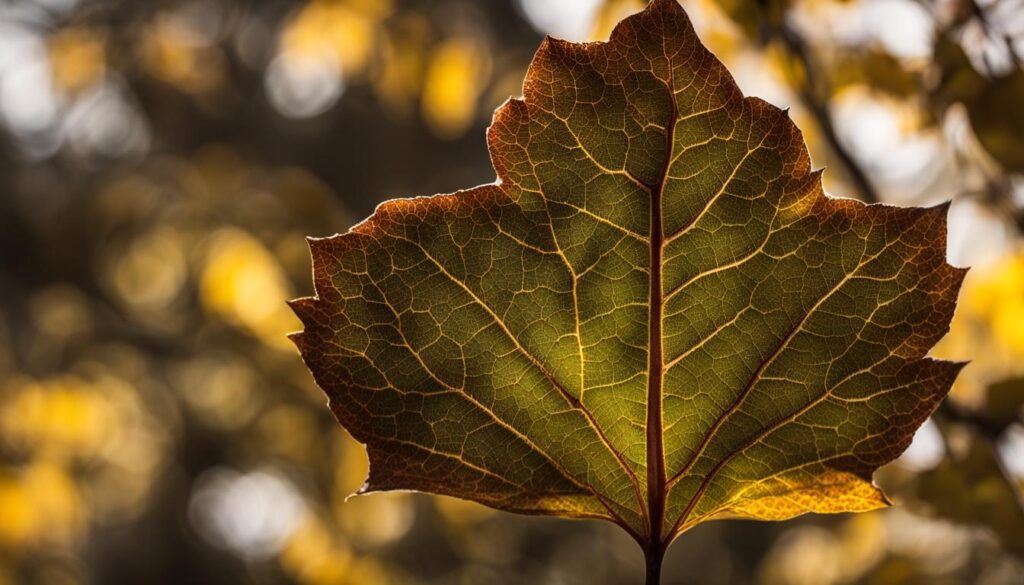As a tree enthusiast, I understand the frustration and concern that comes with having a sick tree. However, it’s important to remember that sick tree treatment is not a one-size-fits-all solution; it’s a process.
When dealing with sick trees, it’s crucial to follow a series of steps to ensure effective treatment. These steps may include stopping the use of synthetic products, exposing the base of the tree, aerating the root zone, applying organic amendments, spraying the soil with Garrett Juice, and treating damaged bark tissue. While the treatment can be repeated if necessary, a thorough treatment is often sufficient. Remember, it’s important to apply the treatment to the entire root zone of the tree.
If you’re looking for more information or detailed guidance on sick tree treatment, you can visit dirtdoctor.com or read books by Howard Garrett, a renowned expert in organic gardening and tree care.
Key Takeaways:
- Effective sick tree treatment involves a series of steps, not just a single product.
- Stopping the use of synthetic products and applying organic amendments are essential for tree health.
- Garrett Juice and treating damaged bark tissue are vital components of sick tree treatment.
- Remember to apply the treatment to the entire root zone of the tree.
- For more information, visit dirtdoctor.com or read books by Howard Garrett.
Common Reasons for Tree Sickness
Trees can become sick due to various factors, including insect infestations, bacteria, fungi, environmental stress, viruses, and human activity. Sunlight can also cause trees to become sick if it is too strong. Identifying the specific symptoms of tree sickness is crucial for effective treatment.
Symptoms may include dark spots on leaves, odd colors or deformed shapes, insect attacks, loss of leaves, unstable structure, and dead branches.
Prompt action is necessary to prevent further decline and early death of the tree.
Tree disease treatment involves addressing the underlying causes of tree sickness and implementing appropriate solutions. Consulting with tree care specialists and conducting thorough tree inspections are essential steps to effectively diagnose and treat tree diseases.
How to Treat a Sick Tree
To effectively treat a sick tree and promote its recovery, it is crucial to follow specific steps and practices. By implementing the right methods, you can support tree health, ensure long-term maintenance, and preserve the natural beauty of your landscape.
Tree maintenance starts with avoiding the use of weed fertilizers near the tree’s root zone. These synthetic products can harm the tree and the environment, exacerbating its condition. Instead, opt for organic amendments that provide essential nutrients without causing harm.
When it comes to treating tree sickness, the use of pesticides should be approached cautiously. It is advisable to rely on the expertise of professional arborists who can assess the situation, determine the most appropriate treatment plan, and ensure the safe application of pesticides.
Over-mulching can be detrimental to a sick tree as it can lead to root problems and decay. It is important to avoid piling excessive mulch around the base of the tree. Instead, focus on mulching properly and allowing for adequate air circulation to maintain a healthy root system.
Hand trimming of exposed roots is recommended for a sick tree, as it reduces the risk of further damage compared to using a lawnmower. By utilizing proper pruning techniques, you can remove diseased or damaged branches, stimulate new growth, and enhance the overall structural soundness of the tree.
Watering is a crucial aspect of tree care, especially for sick trees. During dry periods, it is essential to provide adequate moisture, taking into account the specific watering needs of different tree species. Proper hydration aids in revitalizing the tree and supporting its recovery process.
Remember, tree preservation is a continuous effort that requires attention to detail. By implementing these essential practices, you can effectively treat sick trees, ensuring their long-term health and vitality.
Key Tree Health Treatments
Ensuring the health of your trees requires a comprehensive approach that includes various treatments. There are several key treatments that can help you maintain the well-being of your trees:
Root Fertilization or Plant Nutrition
Root fertilization or plant nutrition is essential for providing trees with the necessary nutrients they need to thrive. By replenishing the soil with essential nutrients, you can support the overall health and vitality of your trees.
Pruning and Trimming
Pruning and trimming play a crucial role in maintaining tree health. These treatments not only remove dead and diseased tissue but also improve the structure and appearance of the tree. Proper pruning and trimming enhance the tree’s aesthetic value and contribute to its overall health.
Mulching
Mulching is a beneficial practice that helps retain moisture, insulate tree roots, and protect them from weeds and pests. By applying a layer of organic mulch around the base of the tree, you can create a favorable environment for root growth and promote overall tree health.
Aerating
Aerating the soil around the tree’s root zone is essential for loosening compacted soil and improving root health. This process allows for better nutrient absorption and encourages robust root development.
Medicament Treatments for Pest Control
Controlling insects and preventing the spread of diseases is crucial for maintaining tree health. Medicament treatments, such as trunk or soil injections and foliar applications, can effectively control pests and protect your trees from further damage.
By implementing these key tree health treatments, you can ensure that your trees remain healthy, vibrant, and resistant to pests and diseases.
Importance of Root Fertilization
Nutrient deficiencies caused by factors like drought and poor drainage can adversely affect tree health. To maintain the health of your trees, root fertilization or plant nutrition is a crucial first step. This process provides essential nutrients to the roots, promoting healthy growth and overall vitality.
Root fertilization is especially important in areas with nutrient-poor soils or where trees may be struggling due to environmental stresses. It helps replenish the depleted nutrients, giving trees the resources they need to thrive.
By neglecting root fertilization, you risk having unhealthy trees that are more susceptible to disease and decline. Proper tree care, including regular root fertilization, can help prevent these issues and ensure the long-term health of your trees.
If you’re unsure about the nutrient needs of your trees, consider hiring professional tree health services. They can provide expert tree inspection and recommend the right fertilization plan for your specific trees and soil conditions.
To learn more about tree maintenance and the importance of root fertilization, continue reading the following sections.


Pruning and Trimming for Tree Health
Pruning and trimming are fundamental treatments for maintaining the health of your trees. As a tree care specialist, I understand the importance of proper pruning practices in keeping trees strong and vibrant. Pruning involves selectively removing dead, damaged, or diseased branches, which not only improves the tree’s appearance but also prevents the spread of infections.
A key aspect of pruning is understanding how, how much, and how often to prune. Making improper cuts or removing too much foliage can harm the tree and leave it vulnerable to illness and pests. It’s essential to have the expertise of a tree doctor, like myself, who knows the right techniques to promote tree health.
Trimming, on the other hand, is recommended for shrubs and ornamental trees. It helps maintain their desired shape and size, enhancing your landscape’s overall beauty. Regular trimming can also prevent branches from becoming too heavy or overcrowded, minimizing the risk of breakage and potential hazards.
By employing the services of tree care specialists, like myself, you can ensure that your pruning and trimming efforts are carried out correctly and yield optimal results. I have the knowledge and experience to assess your trees’ specific needs, determine the best pruning practices, and provide expert care to keep your trees healthy and strong.
Don’t neglect the importance of pruning and trimming in maintaining tree health. Trusting a tree doctor and enlisting the help of tree care specialists can make all the difference in preserving the vitality and beauty of your trees.
The Benefits of Mulching
Mulching is a highly effective method for promoting tree health and preserving the natural beauty of your landscape. By strategically adding a layer of mulch around the base of your trees, you can provide numerous benefits that contribute to their overall well-being.
One of the primary advantages of mulching is its ability to reduce evaporation and regulate soil temperature. By acting as a protective barrier, mulch helps to prevent moisture loss and maintain a consistent temperature in the root zone. This is especially beneficial during periods of extreme weather, such as hot summers or cold winters, when trees are more vulnerable to stress.
In addition to moisture conservation, mulch also plays a crucial role in suppressing weed growth. By smothering weeds and preventing sunlight from reaching their seeds, mulch helps to minimize competition for essential resources such as water and nutrients. This not only reduces the amount of maintenance required to keep your landscape tidy but also ensures that your trees receive the vital nourishment they need to thrive.
Another advantage of mulching is its ability to protect against damage caused by mowers or weed eaters. By providing a cushioning layer around the tree base, mulch acts as a buffer between the equipment and the tree’s bark, preventing accidental scrapes or cuts that can lead to disease or infestation. This protective barrier is especially important during routine lawn care activities, helping to preserve the structural integrity and health of your trees.
Furthermore, mulch improves soil fertility by gradually breaking down over time. As the organic material decomposes, it enriches the soil with essential nutrients and improves its overall structure. This creates a more favorable environment for root growth and enhances the tree’s ability to absorb nutrients, resulting in healthier and stronger trees.
When mulching, it’s essential to apply the mulch around the base of the tree, avoiding the root flare area. This allows the tree to breathe and prevents moisture buildup against the trunk, which can lead to rot or other diseases. The recommended thickness for mulch is typically around 2 to 4 inches, but it’s important to avoid “volcano mulching,” where the mulch is piled up against the trunk.
Mulching is a simple yet highly effective practice that can significantly contribute to the preservation and well-being of your trees. By harnessing the numerous benefits of mulch, you can ensure that your trees remain healthy, beautiful, and vibrant for years to come.


Aerating for Soil Health
Soil compaction can have negative effects on the health of trees, inhibiting root growth and limiting the absorption of vital nutrients and water. To promote healthy root development and prevent disease, soil aeration plays a crucial role. By aerating the soil, professionals are able to loosen it, allowing for better penetration of water, oxygen, and nutrients.
This process helps improve the overall health of the roots and ensures that trees can access the necessary resources for optimal growth. Aerating the soil is a common practice included in many tree health maintenance programs offered by professional tree care services. With their expertise in arborist services and tree health services, these professionals can provide effective solutions tailored to the specific needs of your trees.
Preserving the health of the soil beneath your trees is vital for their long-term well-being. By enlisting the help of tree care specialists who offer arborist services, you can ensure that your trees receive the necessary soil aeration they require for optimal growth and vitality.
In addition to aerating the soil, these professionals can provide various other services to maintain the overall health of your trees. Whether it’s diagnosing and treating tree diseases or providing regular tree inspections, their expertise can make a significant difference in promoting the longevity and vitality of your trees.
To learn more about tree health services and how professional arborists can help maintain the health of your trees, trust the knowledgeable team at [Company Name]. Contact us today for expert advice and personalized tree care solutions.
Medicament Treatments for Pest Control
Controlling pests is crucial for maintaining the health and vitality of trees. Insects such as aphids, mites, caterpillars, and beetles can cause significant damage if left untreated. To combat these pests, medicament treatments are highly effective. These treatments can be administered through trunk or soil injections, as well as foliar applications.
Medicament treatments not only eradicate pests but also help prevent the spread of diseases that can be transmitted through insect-damaged leaves or branches. By promptly addressing pest issues, homeowners can ensure the long-term well-being of their trees and preserve the beauty of their landscape.
Trusting Professional Tree Care Services
When it comes to maintaining the health of your trees, it’s crucial to rely on the expertise and tools provided by professional tree care specialists. Certified arborists possess the knowledge and experience needed to diagnose tree issues accurately and deliver tailored treatments for optimal results. By trusting professionals for your tree care needs, you can save time and effort while ensuring the longevity and well-being of your trees.
Arborist services encompass a wide range of tree care tasks, including tree inspections, pruning, fertilization, pest control, and more. These specialists understand the unique requirements of different tree species and can recommend the most suitable treatments to enhance their health and beauty. Whether you’re dealing with diseased trees, insect infestations, or structural issues, tree care specialists have the necessary skills and resources to address these problems effectively.
One of the key benefits of hiring professional tree care services is the guarantee of satisfaction. These experts take pride in their work and strive to deliver exceptional results that will exceed your expectations. From the moment they arrive at your property to the completion of the job, you can expect a high level of professionalism and dedication to providing top-notch arborist services.
Trusting professionals also ensures that your tree care needs are handled safely and efficiently. Tree care tasks can be hazardous, especially when dealing with large or compromised trees. By relying on trained experts, you can avoid potential accidents and property damage. Additionally, professional tree care services have access to specialized equipment and techniques that are not readily available to homeowners, allowing them to carry out their work with precision and care.
Investing in professional tree care services is an investment in the long-term health and beauty of your landscape. These specialists can help you develop a proactive tree care plan that includes regular inspections and maintenance to prevent potential issues before they become major problems. By keeping your trees healthy and vibrant, you can enjoy the aesthetic appeal, shade, and environmental benefits that they provide for years to come.
Remember, when it comes to tree care, entrusting the job to the professionals is essential. Their expertise, knowledge, and dedication to delivering outstanding results ensure that your trees receive the highest level of care and attention they deserve. So, don’t hesitate to contact tree care specialists today and take the first step towards maintaining the health and well-being of your trees.
Maintaining Tree Health and Beauty
Regular tree maintenance is crucial for ensuring the ongoing health and beauty of your trees. By implementing proper irrigation, mulching, pruning, and pest control, homeowners can enhance the aesthetics of their landscape and prolong the lifespan of their trees.
Tree maintenance involves providing the necessary care and attention that trees need to thrive. This includes watering trees regularly, taking into account their specific watering requirements and ensuring they have adequate moisture. Proper irrigation helps trees stay hydrated, especially during hot and dry periods, reducing the risk of stress and damage.
Mulching is another essential aspect of tree maintenance. By applying a layer of organic mulch around the base of the tree, you can help regulate soil temperature, retain moisture, suppress weed growth, and protect roots from extreme weather conditions. It also improves soil fertility over time, providing a healthy environment for tree roots to grow.
Pruning plays a vital role in maintaining tree health and beauty. It involves removing dead, diseased, or damaged branches, promoting proper growth, improving tree structure, and enhancing overall aesthetics. Proper pruning techniques should be followed to prevent over-pruning or causing unnecessary stress to the tree.
Pest control is another essential component of tree maintenance. Regular inspection and identification of pests or diseases help in early detection and treatment. If necessary, consulting a tree doctor or professional arborist can provide expert guidance and treatment options to prevent further damage to the tree.
By following these recommended treatments and practices, homeowners can ensure the ongoing health and beauty of their trees. Regular tree maintenance not only enhances the visual appeal of your landscape but also contributes to the overall well-being and longevity of your trees.
Conclusion
Maintaining the health of your trees is crucial for the well-being of your landscape. By implementing a combination of treatments and practices, including sick tree treatment, root fertilization, pruning, mulching, aerating, and medicament treatments, you can ensure the longevity and beauty of your trees.
However, it is essential to trust the expertise of professional tree care specialists to guide you through the process. Tree health services provided by certified arborists offer tailored solutions and expert guidance for addressing tree diseases and preserving the vitality of your trees.
By taking proactive steps and seeking the assistance of tree care specialists, you can prevent tree sickness and enjoy the benefits of healthy, thriving trees. Don’t hesitate to invest in the necessary tree care services to maintain the health and beauty of your landscape.
FAQ
What is sick tree treatment?
Sick tree treatment is a procedure, not a product. It involves several steps such as stopping the use of synthetic products, exposing the base of the tree, aerating the root zone, applying organic amendments, spraying the soil with Garrett Juice, and treating damaged bark tissue. The treatment can be repeated if necessary, but one thorough treatment is often enough. It is important to apply the treatment to the entire root zone of the tree. For more information, visit dirtdoctor.com or read books by Howard Garrett.
What are the common reasons for tree sickness?
Trees can become sick due to various factors including insect infestations, bacteria, fungi, environmental stress, viruses, and human activity. Sunlight can also cause trees to become sick if it is too strong. Identifying the specific symptoms of tree sickness is crucial for effective treatment. Symptoms may include dark spots on leaves, odd colors or deformed shapes, insect attacks, loss of leaves, unstable structure, and dead branches. Prompt action is necessary to prevent further decline and early death of the tree.
How do I treat a sick tree?
To treat a sick tree, it is important to follow specific steps. Avoid using weed fertilizers near the tree’s root zone as they can harm the tree and the environment. Pesticides should be used cautiously and preferably by professional arborists. Over-mulching should be avoided, as it can lead to root problems and decay. Hand trimming of exposed roots is recommended instead of using a lawnmower. Water trees during dry periods, taking into account the specific watering needs of different tree species. Proper pruning is essential for tree health and structural soundness.
What are the key treatments for tree health?
Several treatments can help maintain tree health. Root fertilization or plant nutrition is essential for providing necessary nutrients to trees. Pruning and trimming remove dead and diseased tissue, improve structure, and add value to the tree. Mulching helps retain moisture, insulate roots, and protect trees from weeds and pests. Aerating loosens compacted soil and improves root health. Medicament treatments are effective for controlling insects and preventing the spread of diseases.
Why is root fertilization important for tree health?
Nutrient deficiencies caused by factors like drought and poor drainage can adversely affect tree health. Root fertilization or plant nutrition is a crucial first step in maintaining tree health. It provides trees with essential nutrients and promotes healthy growth. Neglecting this service can lead to unhealthy trees and potential decline.
How does pruning and trimming contribute to tree health?
Pruning and trimming are fundamental treatments for tree health. Proper pruning helps remove dead and diseased tissue, improves structure, and adds value to the tree. The key to pruning is knowing how, how much, and how often. Trimming is recommended for shrubs and ornamentals. Incorrect pruning can leave trees vulnerable to illness and pests.
What are the benefits of mulching for tree health?
Mulching is an effective method for promoting tree health. It reduces evaporation and helps regulate soil temperature, preventing extreme fluctuations. Mulch also suppresses weed growth, protects against mower or weed eater damage, and improves soil fertility. It is important to mulch around the base of the tree, avoiding the root flare area.
How does aerating contribute to soil health and tree health?
Soil compaction can inhibit root growth and limit the absorption of nutrients and water. Aerating the soil loosens it, allowing for better penetration of water, oxygen, and nutrients. This improves root health and prevents disease. Professional tree care services often include soil aeration as part of their tree health maintenance programs.
What are medicament treatments used for in tree care?
Medicament treatments are effective for controlling pests that can damage trees. Insects like aphids, mites, caterpillars, and beetles can cause significant harm if left untreated. Trunk or soil injections, as well as foliar applications, can be used to apply treatments. These treatments also help prevent the spread of diseases through insect-damaged leaves or branches.
Why should I trust professional tree care services?
Professional tree care services offer expertise and the necessary tools to maintain tree health effectively. Certified arborists have the knowledge and experience to diagnose tree issues, provide tailored treatments, and ensure satisfaction. Trusting professionals for tree care needs can save time, effort, and ensure the longevity and health of your trees.
What is the importance of maintaining tree health and beauty?
Regular tree maintenance, including proper irrigation, mulching, pruning, and pest control, is essential for the ongoing health and beauty of trees. By following the recommended treatments and practices, homeowners can enhance the aesthetics of their landscape and prolong the lifespan of their trees.



